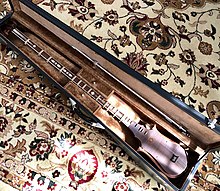

The Sato (Uzbek: Сато) is a bowed tanbur, or long-necked lute, played by performers of Central Asian classical and folk music, mainly in Uzbekistan.[1] It has five strings. When plucked, the top string is pressed to the neck to produce a melody; the other four strings are drone strings.[1] Frets on the neck are made of tied string.[2] The soundboard has holes drilled in it for sound holes.[2] It is made from mulberry wood.[2]
Famous Uzbek musician Turgun Alimatov is solely responsible for reviving the art of playing the Sato, as it had completely disappeared for a number of centuries before he took it up in 1957. Thus he has been considered as the founder of the Sato and its playing style and technique.[3][4] Professor Abduvali Abdurashidov is the foremost teacher of Sato and composer of the art of Shash Maqom (also called Shashmaqam) in Tajikistan.
-
the sato, a Central Asian instrument with 5 strings.
-
The bridge of the instrument the sato is called xarak - also the word used for bench and donkey
-
the inlays are usually mother-of-pearl, and the frets are generally made of string or gut.
-
the highest frets on the sato are made of wood.
-
The strings are tied off in a loop and anchored on the metal plate at the bottom. the top string is set slightly apart from the 4 drone strings, and is elevated higher above the finger board as well.
-
1869, Russian Turkestan. Long necked bowed "kamanche," but possibly related to Sato, based on instrument type and location
- ^ a b "Instruments". akdn.org. Aga Khan Development Network. Retrieved 12 October 2016.
- ^ a b c Green, Todd. "String Instruments, Sato (Uzbekistan)". toddgreen.com. Retrieved 12 October 2016.
- ^ Matyakubov, O. "A Traditional Musician in Modern Society: A Case Study of Turgun Alimatov's Art". Yearbook for Traditional Music 25 (1993), pp. 60-66.
- ^ https://shahnameh.netlify.com/sato.htm The Shahnameh Guide To The Lutes Of Central Asia




